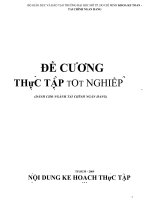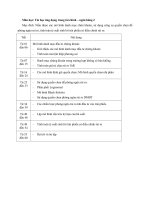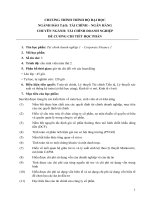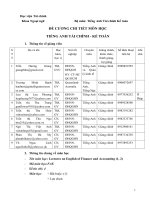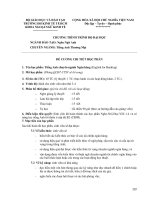Đề cương học phần học phần tiếng anh tài chính ngân hàng
Bạn đang xem bản rút gọn của tài liệu. Xem và tải ngay bản đầy đủ của tài liệu tại đây (279.19 KB, 40 trang )
<span class="text_page_counter">Trang 1</span><div class="page_container" data-page="1">
ĐẠI HỌC THÁI NGUYÊN
</div><span class="text_page_counter">Trang 2</span><div class="page_container" data-page="2"><b>ĐẠI HỌC THÁI NGUYÊN CỘNG HÒA XÃ HỘI CHỦ NGHĨA VIỆT NAMTRƯỜNG NGOẠI NGỮ Độc lập – Tự do – Hạnh phúc</b>
<b>ĐỀ CƯƠNG HỌC PHẦN</b>
<b>HỌC PHẦN: TIẾNG ANH TÀI CHÍNH NGÂN HÀNG</b>
(English For Finance and Banking) MÃ SỐ HỌC PHẦN: EFB331
<b>1. Thông tin chung về Học phần</b>
- Thuộc khối kiến thức/ kỹ năng: Kiến thức giáo dục đại cương Kiến thức cơ sở ngành
Kiến thức ngành
<i> Kiến thức chun ngành (nếu có) </i>
- Số tín chỉ: 03 <i>Loại Học phần: (bắt buộc, tự chọn): bắt buộc</i>
- Áp dụng cho ngành/chuyên ngành đào tạo: Ngôn ngữ Anh - Phân bổ tín chỉ đối với các hoạt động:
</div><span class="text_page_counter">Trang 3</span><div class="page_container" data-page="3"><b>2. Các điều kiện tham gia Học phần:</b>
1. Th.S Lê Thị Khánh Linh 0946277288 2. Th.S Lê Thị Thu Trang 0972602666 3. Th.S Lê Thị Nhung 0919682881 4. Th.S Phí Thị Mùi 0915991829
5. Th.S Đỗ Thị Trang Nhung 0946236789
<b>4. Mô tả học phần </b>
Học phần Tiếng Anh tài chính ngân hàng thuộc nhóm mơn học giáo dục chun ngành, xây dựng cho sinh viên năm thứ 4 ngành Ngôn ngữ Anh (dự kiến học kỳ 7). Môn học nhằm trang bị cho sinh viên chuyên ngành Ngôn ngữ Anh những kiến thức cơ bản về tiếng Anh trong lĩnh vực tài chính ngân hàng, từ đó giúp sinh viên có nền tảng vững chắc cho việc sử dụng tiếng Anh chính xác và hiệu quả trong lĩnh vực này. Học phần trước hết cung cấp cho sinh viên các thuật ngữ chuyên môn cơ bản về lĩnh vực tài chính ngân hàng. Bên cạnh đó, được trang bị các kiến thức chuyên môn đơn giản như tiền tệ và lưu thông tiền tệ, các kỹ năng và nghiệp vụ ngân hàng và một số những kiến thức chun mơn khác. Ngồi ra, sinh viên được nâng cao kỹ năng làm việc khi làm việc độc lập và theo nhóm, kỹ năng ứng dụng cơng nghệ thơng tin, kỹ năng giải quyết vấn đề thông qua các hoạt động trên lớp và dự án nhóm.
Hình thức tổ chức dạy học của môn học đa dạng, bao gồm sinh viên học và luyện tập trên lớp với giảng viên, với nhóm học tập, tự đọc, nghiên cứu tài liệu ở nhà, tự học có hướng dẫn với giảng viên (E-learning) thông qua hệ thống quản lý học trực tuyến.
<b>5. Mục tiêu học phầnMục tiêu</b>
<b>Mô tả mục tiêu Học phần (Course Goals)</b>
<b>Học phần này trang bị cho sinh viên:<sup>CĐR CTĐT</sup></b>
Những thuật ngữ, cụm từ và ngữ pháp chuyên ngành trong lĩnh vực tài chính và ngân hàng. Điều này bao gồm từ vựng liên quan đến hệ thống tài chính, các dịch vụ ngân hàng, quản lý rủi ro, đầu tư, và các khía cạnh khác của ngành.
<b>G2</b> Kỹ năng thuyết trình một cách hiệu quả nhằm diễn giải được vấn đề và giải pháp thuộc linh vực Tài chính Ngân hàng.
Kỹ năng giao tiếp một cách tự tin, phù hợp trong môi trường Tài chính Ngân hàng.
<b>PLO8</b>
</div><span class="text_page_counter">Trang 4</span><div class="page_container" data-page="4">Kỹ năng làm việc độc lập với nhiện vụ được giao. <b>PLO9</b>
Kỹ năng làm việc theo nhóm khi được yêu cầu phối hợp với đồng nghiệp để giải quyết nhiệm vụ chung.
Kỹ năng khởi nghiệp để định hướng công việc trong tương lai của bản thân
Kỹ năng sử dụng tiếng Anh để thực hiện các nhiệm vụ chuyên môn trong lĩnh vực tài chính ngân hàng.
<b>Mơ tả chuẩn đầu ra</b>
<i>Sau khi học xong Học phần này, sinh viên có</i>
CLO1.1 <sup>Phân biệt các từ vựng Tiếng Anh sử dụng trong</sup><sub>lĩnh vực tài chính ngân hàng</sub> <b><sup>PLO3</sup><sup>M</sup></b> CLO1.2 <sup>Phân tích các đặc điểm ngôn ngữ của Tiếng</sup><sub>Anh sử dụng trong lĩnh vực tài chính ngân hàng</sub> <b><sup>PLO3</sup><sup>M</sup></b>
Diễn giải được vấn đề, quan điểm, bản thân và nhóm làm việc một cách hiệu quả, qua các hình thức khác nhau
Giới thiệu, thuyết trình một cách độc lập hoặc phối hợp cùng các thành viên khác khi làm việc nhóm
Nhận diện được các nghề nghiệp, nhiệm vụ, thao tác liên quan đến lĩnh vực Tài chính ngân hàng
Sử dụng ngôn ngữ tiếng Anh để phục vụ các hoạt động chuyên môn như đọc hiểu các văn bản về lĩnh vực tài chính ngân hàng; viết tương tác để thực hiện một nhiệm vụ chuyên môn
<b>G3</b> CLO3.1 <sup>Tự học, tự tìm tịi để nâng cao kiến thức, kỹ</sup><sub>năng của bản thân</sub> <b><sup>PLO14</sup><sup>M</sup></b>
<b>*Ghi chú:</b>
- Mức độ đóng góp của CĐR HP (CLO) đối với CĐR CTĐT (PLO) được xác định bằng thang đo 3 mức như sau (điền một trong các mức I, R, M).
+ I (Introduced): CLO có hỗ trợ đạt được PLO và ở mức giới thiệu/bắt đầu
+ R (Reinforced ): CLO có hỗ trợ đạt được PLO và ở mức nâng cao hơn mức bắt đầu, có nhiều cơ hội được thực hành, thí nghiệm, thực tế,…
+ M (Mastery): CLO hỗ trợ mạnh mẽ sinh viên trong việc thuần thục/thành thạo hay đạt được PLO. Nếu sinh viên hồn thành tốt CLO này thì xem như sinh viên đã ở mức thuần thục/thành thạo một nội hàm quan trọng của PLO hoặc thậm chí thuần thục/thành thạo tồn bộ PLO đó.
<b>7. Chuẩn đầu ra bài học </b>
</div><span class="text_page_counter">Trang 5</span><div class="page_container" data-page="5"><b>Tên bài họcCĐR bài học</b>
<b>(LLOs)</b> <sub>CLO1.1</sub> <sub>CLO1.2 CLO2.1 CLO2.2 CLO2.3 CLO2.4 CLO3.1</sub><b><sup>Mức độ đóng góp của LLO với CLO</sup></b>
được tên gọi các công việc liên
<b>LLO7: Trao đổi,</b>
viết thư tương tác
<b>LLO10: Phân biệt</b>
được được khái
</div><span class="text_page_counter">Trang 7</span><div class="page_container" data-page="7">kiếm thông tin về đầu tư trong ngân
<b>LLO27: Viết báo</b>
cáo kết quả kinh cần thiết cho mỗi một công việc liên quan đến ngành nghề kế tốn.
</div><span class="text_page_counter">Trang 8</span><div class="page_container" data-page="8">các thơng tin tài liệu liên quan đến
</div><span class="text_page_counter">Trang 9</span><div class="page_container" data-page="9">website liên quan
hiện hội thoại của tư vấn viên tài
hoạch tìm kiếm tài liệu liên quan đến
</div><span class="text_page_counter">Trang 10</span><div class="page_container" data-page="10"><b>companies</b> cơ bản về dòng tiền, bản cân đối kế toán, báo cáo
<b>LLO47: Viết báo</b>
cáo kết quả kinh doanh của công ty trong bài nghe.
tập, nghiên cứu tài liệu liên quan đến lược sửa đổi các khoản vay của
</div><span class="text_page_counter">Trang 11</span><div class="page_container" data-page="11"><b>LLO54: Viết thư</b> khoản vay và bên cho thuê tài sản, điều khoản cho vay, khái niệm tái cơ cấu ngân hàng
</div><span class="text_page_counter">Trang 12</span><div class="page_container" data-page="12">- Mức độ đóng góp của CĐR bài học (LLO) đối với CĐR học phần (CLO) được xác định bằng thang đo 3 mức như sau. Điền một trong các mức I, R, M hoặc chừa trống (nếu khơng có sự liên hệ).
+ I (Introduced): LLO có hỗ trợ đạt được CLO và ở mức giới thiệu/bắt đầu
+ R (Reinforced ): LLO có hỗ trợ đạt được CLO và ở mức nâng cao hơn mức bắt đầu, có nhiều cơ hội được thực hành, thí nghiệm, thực tế,…
+ M (Mastery): LLO hỗ trợ mạnh mẽ sinh viên trong việc thuần thục/thành thạo hay đạt được CLO. Nếu sinh viên hoàn thành tốt LLO này thì xem như sinh viên đã ở mức thuần thục/thành thạo một nội hàm quan trọng của CLO hoặc thậm chí thuần thục/thành thạo tồn 1.1. Getting to know you 1.2. Names and numbers 1.3. Paying for things 1.4. Managing your money
</div><span class="text_page_counter">Trang 13</span><div class="page_container" data-page="13">Giao việc Giao việc
<i><b>C. Nội dung về bài tập lớn, tiểu</b></i>
2.2. What do you do everyday? 2.3. What’s your job?
</div><span class="text_page_counter">Trang 14</span><div class="page_container" data-page="14"><i><b>C. Nội dung về bài tập lớn, tiểu</b></i>
3.1. Products and services 3.2. What can you do?
3.3. What can banks give to
- Watch video – What the world bank really do?
</div><span class="text_page_counter">Trang 15</span><div class="page_container" data-page="15">4.1. What are they doing? 4.2. How can I help you?
</div><span class="text_page_counter">Trang 16</span><div class="page_container" data-page="16"><i><b>C. Nội dung về bài tập lớn, tiểu</b></i> 5.2. Spreading the risk 5.3. The stock market
5.4 Arangements and appointments
</div><span class="text_page_counter">Trang 17</span><div class="page_container" data-page="17">6.1. Who needs accountants? 6.2. What do accountants do?
</div><span class="text_page_counter">Trang 18</span><div class="page_container" data-page="18">7.1. Managing your finances 7.2. Finance and the economy 7.3. Banks and building societies
</div><span class="text_page_counter">Trang 20</span><div class="page_container" data-page="20">+ E- learning (giờ): 3
- Searching learning materials themselves
<i><b>C. Nội dung về bài tập lớn, tiểu</b></i>
</div><span class="text_page_counter">Trang 22</span><div class="page_container" data-page="22">10.2. The structure of the bank 10.3. The changing world of
- Watch video: Banking Sector Outlook in Vietnam: Opportunities & Challenges | FiinGroup x
</div><span class="text_page_counter">Trang 23</span><div class="page_container" data-page="23"><i><b>C. Nội dung về bài tập lớn, tiểu</b></i>
11.2. The balance sheet 11.3. The income statement 11.4. The cash flow statement
- Watch video: An Introduction to the Financial Industry
</div><span class="text_page_counter">Trang 24</span><div class="page_container" data-page="24">12.2. Loans, credit lines and leasing 12.3. Company restricting and loan
- Watch video: An Introduction to the Financial Industry
</div><span class="text_page_counter">Trang 27</span><div class="page_container" data-page="27"><b>9. Phương pháp kiểm tra đánh giá Học phần</b>
<b>Hình thức đánh giá<sup>Nội dung</sup><sub>đánh giá</sub><sup>Trọng</sup><sub>số</sub><sub>đánh giá</sub><sup>Phương</sup></b>
</div><span class="text_page_counter">Trang 28</span><div class="page_container" data-page="28"><b>- Tài liệu bắt buộc </b>
<i>[1]. Rosemary Richey, David Bonamy, English for banking and finance 1, Pearson Education</i>
Limited, 2011
<i>[2]. Marjorie Rosenberg, Series editor David Bonamy, English for banking and finance 2,</i>
Pearson Education Limited, 2012
<i> [5]. Jon Marks., Check your english vocabulary for banking and finance. A& C Black </i>
Business Information and Development, 2009
<i>[6]. Marie McClisky, English for banking in Higher Education Studies Course Book, </i><small>Garnet Education, 2012</small>
<i>[7]. Richard Clark, David Baker, Oxford English for Careers Finance 1, Oxford University </i>
Press, 2011
<b>- Websites</b>
</div><span class="text_page_counter">Trang 29</span><div class="page_container" data-page="29"><small>1.</small> Nhiệm vụ của sinh viên- Phần lý thuyết:</b>
<i>- Chuẩn bị bài trước khi học trên lớp;</i>
<i>- Dự lớp 80 % tổng số thời lượng của Học phần.</i>
<i><b>- Phần thực hành, thảo luận, bài tập: Hoàn thành các bài thực hành được giao trên lớp</b></i>
<i>hoặc ở nhà/ cá nhân và theo nhóm. </i>
<small>- Giới thiệu mục tiêu và nội dung Học phần (Course Outline và Learning Outcomes);- Giới thiệu tài liệu học tập chính và tài liệu tham khảo;</small>
<small>- Thơng tin về phương pháp đánh giá q trình và kết thúc học phần, quy định của họcphần: học trên lớp/ học online, E-learning, kiểm tra…</small>
<b><small>Trong các buổi học: </small></b>
<i><small>- Hình thức tổ chức dạy học trong giờ lý thuyết: thuyết giảng, thảo luận và làm việc nhóm.</small></i>
<small>+ Thuyết giảng, thảo luận: chủ yếu dựa vào việc phân tích, chỉ ra các mâu thuẫn, cách thức giải quyếtcác nội dung của môn học. Các nội dung dạy học được lồng ghép vào trong các tình huống cụ thể(khoảng từ 2-3 tình huống vấn đề/ unit). Dưới sự hướng dẫn của giảng viên, sinh viên sẽ thảo luận, tựđề xuất, tìm ra hướng giải quyết. Giảng viên có thể cung cấp thêm các thông tin bổ trợ và giúp điềuchỉnh hướng giải quyết của sinh viên ngay trên lớp.</small>
<small>+ Làm việc nhóm: Lớp học phần được chia thành các nhóm học tập với số lượng sinh viên hợp lýtrong mỗi nhóm. Giờ làm việc nhóm được tiến hành triển khai sau giờ lý thuyết khi giáo viên yêu cầusinh viên làm các tập thực hành. Trong giờ làm việc nhóm giảng viên đóng vai trị người hướng dẫn,hỗ trợ, điều khiển, giám sát và quản lý.</small>
<i><b><small>- Các hình thức dạy học ngồi giờ lên lớp: giờ tự học có hướng dẫn của giáo viên bao gồm hoàn</small></b></i>
<small>thành các nhiệm vụ học tập trong Tài liệu bài tập và Online. </small>
<b><small>Trong buổi học cuối: </small></b>
<small>Giáo viên thông tin về cấu trúc đề thi kết thúc học phần cho người học nắm rõ.</small>
<b>13. Phụ trách Học phần</b>
- Khoa phụ trách: Tiếng Anh
- Ngày nghiệm thu cấp Khoa: . . .
- Cập nhật lần tiếp theo (dự kiến): . . . ………… . . .
</div><span class="text_page_counter">Trang 32</span><div class="page_container" data-page="32"><b><small>RUBRIC 1: STUDENTS’ PORTFOLIO </small></b>
<b><small>Does not meet </small></b>
<small>The portfolio documents some, but not sufficient, learning tied to sound educational theory (or grounded in appropriate academic frameworks)</small>
<small>The portfolio adequately documents learning tied tosound educational theory (or grounded in </small>
<small>appropriate academic frameworks)</small>
<small>The portfolio provides clear evidence of learning tied to sound educational theory (or</small>
<small>The portfolio provides littleevidence of the student’s ability to use knowledge and skills for the course’s learning outcomes in practice</small>
<small>The portfolio demonstratesthe student’s ability to use the knowledge and skills for the course learning outcomes in practice is limited</small>
<small>The portfolio documents the acquisition of knowledge and skills for the course learning outcomes, with some ability to apply them in practice</small>
<small>The portfolio demonstrates the student has mastered the knowledge and skills for the course learning </small>
<small>outcomes and can apply learning aligned with the course learning outcomes for which credit is being sought</small>
<small>The portfolio provides inadequate evidence of reflection to increase learning aligned with the course learning outcomes for which credit is being sought</small>
<small>The portfolio provides evidence of reflection to increase learning aligned with the course learning outcomes for which credit is being sought</small>
<small>The portfolio shows that the student has reflected with substantial depth upon how the prior learning </small>
<small>experience is aligned to the course learning outcomes for which credit is being </small>
<small>2.12.22.4</small>
</div><span class="text_page_counter">Trang 33</span><div class="page_container" data-page="33"><small>soughtPresentationAssembly instructions </small>
<small>have not been followed with critical portfolio elements not included; thequality of written, visual and/or digital presentation does not meet </small>
<small>postsecondary standards</small>
<small>Most of the expected elements are included; thequality of written, visual and/or digital presentation does not meet </small>
<small>postsecondary standards with too many errors in spelling, grammar and punctuation</small>
<small>The portfolio is well organized with all critical elements included; the quality of written, visual and/or digital the </small>
<small>presentation is competent with minor errors in spelling, grammar and punctuation</small>
<small>The portfolio is well organized with all critical elements included; learning is well documented with writing and production skills that exceed those of most </small>
</div><span class="text_page_counter">Trang 34</span><div class="page_container" data-page="34"><b><small>RUBRIC 2: PRESENTATION ASSESSMENT</small></b>
<small>Skillfully report on a topic with many appropriate facts and relevant, descriptive details. Excellent mixture of graphics and texts. Easy to navigate.</small>
<small>Provide appropriate facts and relevant, descriptive details.</small>
<small>Add graphics or other visual displays to clarify ideas and thoughts. </small>
<small>Attempt to provide informationabout a topic, but with limited details. Include some drawings or visual displays, but they maybe limited or unrelated.</small>
<small>Provide minimal description oftopic with few details. Lack drawings or visual displays. </small>
<small>Recall and gathers information from multiple additional sources to strengthen presentation.</small>
<small>Recall information from experiences or gather information from some other print or digital sources.</small>
<small>Recall information from experiences or gather some information from provided print or digital sources.</small>
<small>Only recall information from experience. Does not use information from provided or </small>
<small>Skilfully design relevant and accurate questions that can evaluate learners’ key knowledge of the topic. </small>
<small>Design good questions that can evaluate learners’ knowledge of the topic. Encounter some mechanic mistakes or miss some key information.</small>
<small>Design some questions to test leaners’ knowledge. Make some mistakes related to accuracy or relevance. </small>
<small>Design very few appropriate questions. Lack of accuracy or include many confusing </small>
</div><span class="text_page_counter">Trang 35</span><div class="page_container" data-page="35"><b><small>Presentation strategies…/2</small></b>
<small>Hold attention with audience by maintaining direct eye contact with all audience.</small>
<small>Fluctuate volume and inflection to maintain audience interest and to emphasize key points.</small>
<small>Maintain eye contact with most </small>
<small>Sometimes speak inaudibly andunclearly in some part of presentation</small>
<small>Have minimal or no eye contact that may cause audience to disengage. Speak mostly inaudibly and unclearly</small>
<small>Demonstrate skilful command of the conventions of spoken standard English grammar and usage that exceeds grade level expectation.Accurately use general academic and domain – specific words and phrases acquired through the presentation. </small>
<small>Demonstrate command of the conventions of spoken standard English grammar and usage. Use topic – specific words and phrases acquired through the presentation.</small>
<small>Make minor errors of spoken standard English grammar and usage that do not interfere with meaning.</small>
<small>Use minimal topic – specific vocabulary during presentation.</small>
<small>Lack command of spoken standard English grammar and usage. Use general vocabulary with limited vocabulary about </small>
<b><small>Based on EVALUATION FORM FOR TEAM WORK</small></b>
<b><small>Peer Evaluation Form for Team Work</small></b>
<small>Your name ____________________________________________________</small>
<small>Write the name of each of your group members in a separate column. For each person, indicate the extent to which you agree with the statement on the left, using a scale of 1-4 (1=strongly disagree; 2=disagree; </small>
<small>2.2</small>
</div><span class="text_page_counter">Trang 36</span><div class="page_container" data-page="36"><small>3=agree; 4=strongly agree). Total the numbers in each column.</small>
<small>Attends group meetings regularly and arrives on time.and supportive attitude.</small>
<small>Contributes significantly to the success of the project.</small>
<small>Feedback on team dynamics:</small>
<small>1. How effectively did your group work?</small>
<small>2. Were the behaviors of any of your team members particularly valuable or detrimental to the team? Explain.</small>
<small>3. What did you learn about working in a group from this project that you will carry into your next group</small>
</div>